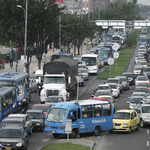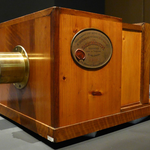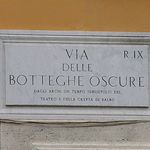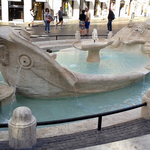Piazza Navona
It is one of the most harmonious, spectacular and characteristic city complexes of the baroque Rome delimitating the buildings which rose up on the remains of the Domitian stadium. The remains of the stadium are included in the buildings on the northern side of the square.
At the beginning it was a circus without lions and gladiators. The emperor Domition was a peaceful man who loved the horse races and competitions of athletes called "agoni". From this word the name Navona derives falsely (agone, nagone, navone, navona).
Inaugurated in 81 A.C the Domition Stadium was 240 meters long and 65 meters wide. The actual square preserves the form and the dimensions of the ancient camp with the only difference of the ground which has been raised in 6 meters covering the cavea and the tribune of travertine. The tribunes were crowded by more than 30.000 spectators to give a hand to agonali. Some remains of the stadium are still visible in the rear of Piazza Tor Sanguigna and in the basements of the Sant' Agnese church.
Over the corse of time the square had always preserved its festive character. Folk parties, races and games took place in the square through the centuries.
Beginning from 1653 for more than a century from Saturday morning untill Sunday night the square was flooded with water. Within two hours the water filled it all and the equipages of the prelates and the princes specially dressed for the party came here. Around them the most lively din of the folks got loose here. Some of them was navigating here on the carriages of the gondola form. The other ones were swimming here while the horses toddled and sometimes drowned.
In 1810 in occasion of the angel's day of Napoleon I a big horse race was organized with jockeys dressed as ancient Romans. For the winners there was no money prize but a workplace at the Council.
Nowadays from December 1 untill January 6 the square is filled with souvernir-stalls. The market crib of figures, toys, sweets and fifers which came from Abruzzo to create the Christmas atmosphere ringing their ancient sing-songs. The square is always much crowded during the day. The people come here to take the sun in the daytime, to take ice-cream in the evening and to wait the dawn in the night.
Three fountains adorn the square:
The Fountain del Moro in front of the Panphili palace, so called because of the statue of the Ethiopian who fights with a dolphin. It is a work of art of Giovanni Antonio Mari created in 1654 by the sketch of Bernini. It was ordered by Olimpia Maidalchini who was a sister -in-law of Innocent X for to enrich the polylobed basin of Giacomo della Porta in 1575 which Gregorio XIII had ordered to place in the square. The tritons and the other ornaments around
are copies of Luigi Amici. They were placed here in 1874 instead of the pre-existent ones belonging to the several sculptors of the Cinquecento. Nowadays they are used for the fountains in the garden of the lake of Villa Borghese, as well as four masks which alternated by the tritons and which came from the fountain erected by the same Della Porta in 1573 in Piazza del popolo and which was removed by Valadiet in 1823. The pool excavated around the basin from which the beautiful drawing derive also belongs to Bernini created by the design of Borromini.
The Fountain of the Nettuno, in the past called the fountain of coppersmiths, with a basin and polylobed cup, also created by Della Porta in 1576 had remained bare until 1878. That year for to make a comparison with that one of Moro the competition was announced and the sculpture of Nettuno which fights against the octopus was placed here. The composition is created by Della Bitta. The nereids, puttos and sea horses were created by Zappalà.
In the center of the square one of the most beautiful and fanciful works of Bernini Fontana dei Fiumi dominates. Bernini gained with the help of it the favour of Innocent X who was hostile towards him at first. In the middle of a wide round basin a rock excavated from grottos stands out from where a lion and fantastic animals go out to water in the fountain fed by eight veils of water. On the rock the travertine statues once colored are set representing the Nile, the Gang, the Danube,and the Rio della Plata. They represent created by Giacomo Antonio Fancelli, Claudio Poussin, Antonio Raggi and Francesco Baratta. Above the rock Bernini raised hazardously an obelisk which is a Roman imitation from the Domition time. It came from the Maxenzius circus. On the top there is a dove made of bronze with the coat of arms of the Pamphili 1,78 meters high.
The legend attributes meanings of the rivalry and enmity between Bernini and Borromini to the gestures of the statues of the rivers. Borromini was an author of the frontlying church Sant' Agnese in Agone: the Plata extends the hand to avoid the imminent collapse of the façade of the church. The Nile has the veiled head for to make the allusion to its unknown sources of the epoch and for not to see the disgust of the Borromini building. In its turn Sant' Agnese statue lying on the base of the bell tower of the church assures with the hand on the chest that the church would not fall.
To face the expenses of his building the Pope Innocent X introduced a tax on the bread for more than 29 thousand shields since what the people protested until 1651 when Bernini presented its completed work. So then the common people applauded either.
The Sant' Agnese in Agone church was built in the place where according to the tradition the Holy Agnese was exposed naked to the pillory and was miracolously covered by his loose hair. The building begun under Innocent X in 1652 by Girolamo and Carlo Rainaldi was finished by Borromini between 1653 and 1657.

 The records of Rome. Big numbers, not always enviable, for a big city.
The records of Rome. Big numbers, not always enviable, for a big city. New Phot-O-Matic section. To spend some time looking at photos (also) of Rome.
New Phot-O-Matic section. To spend some time looking at photos (also) of Rome. The administrative, urban, toponymic and imaginative subdivisions of Rome.
The administrative, urban, toponymic and imaginative subdivisions of Rome. Notice for tourists: in Rome you drink for free. Historical fountains and 'big noses'.
Notice for tourists: in Rome you drink for free. Historical fountains and 'big noses'. Free museums return on the first Sunday of the month.
Free museums return on the first Sunday of the month.